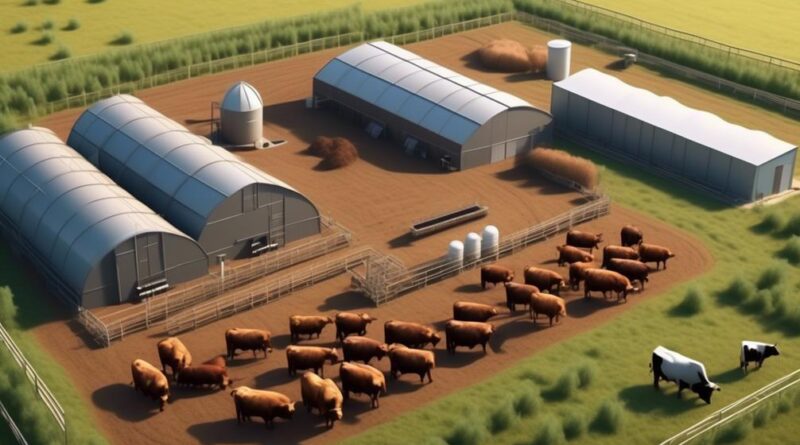Reducing Methane Emissions in Cattle Farming: A How-To Guide
You know the saying, 'Where there's a will, there's a way.' When it comes to reducing methane emissions in cattle farming, this adage holds true.
As a cattle farmer, you understand the importance of sustainability and environmental responsibility. But with the increasing focus on greenhouse gas emissions, finding effective ways to mitigate methane from your operations is more crucial than ever.
There are practical steps you can take to address this challenge, and by implementing the right strategies, you can make a significant impact.
In the following guide, we will explore actionable methods to reduce methane emissions in cattle farming and pave the way for a more sustainable future.
Understanding Methane Emissions
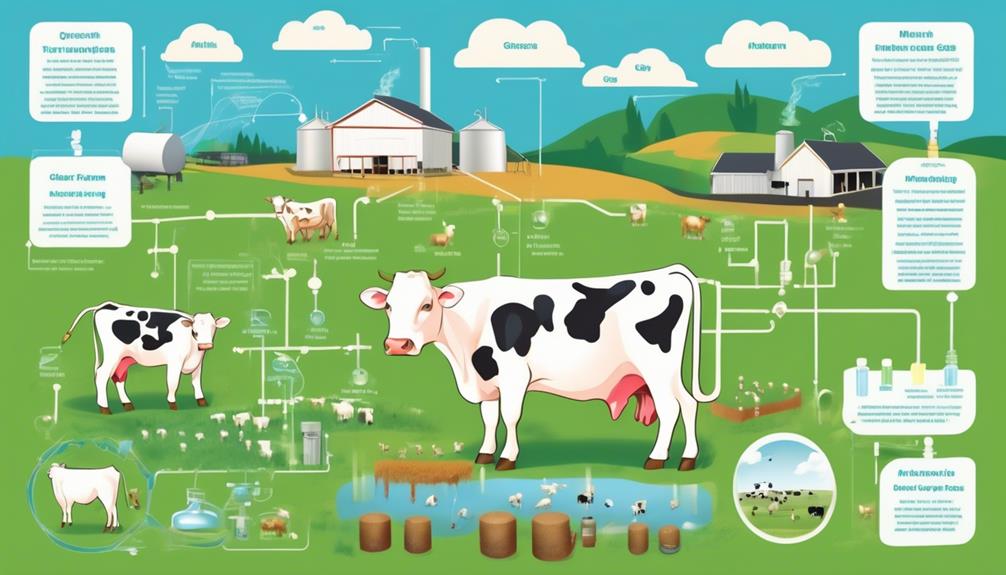
To understand methane emissions in cattle farming, it's important to grasp the key sources and factors contributing to their production. Methane production in cattle primarily occurs during the process of enteric fermentation, which is the digestion of food in the rumen. This natural biological process allows microorganisms in the digestive system of cattle to break down fibrous plant material, releasing methane as a byproduct. Additionally, methane emissions can also result from manure management practices on farms.
The environmental impact of methane emissions in cattle farming is significant. Methane is a potent greenhouse gas, with a global warming potential around 28 times greater than carbon dioxide over a 100-year period. As a result, it significantly contributes to climate change and poses a threat to the environment. In addition to its impact on global warming, methane also plays a role in the formation of ground-level ozone, which can have detrimental effects on air quality and human health.
Understanding the sources and environmental impact of methane emissions is crucial for developing effective strategies to mitigate their effects in cattle farming. By addressing the factors contributing to methane production and implementing sustainable practices, such as dietary adjustments for cattle and improved manure management techniques, it's possible to reduce the environmental impact of methane emissions in the agricultural sector.
This understanding is essential for developing targeted solutions to minimize methane emissions while maintaining efficient and sustainable cattle farming practices.
Implementing Dietary Changes
Cattle farmers can significantly reduce methane emissions by implementing dietary changes that target the factors contributing to methane production during enteric fermentation and improve overall sustainability in farming practices. Here are some practical dietary changes you can implement to mitigate methane emissions:
- Nutritional supplements: Introducing feed additives such as seaweed, oilseeds, and tannins can help reduce methane emissions from cattle. These supplements have been shown to inhibit the microbes responsible for methane production in the rumen, thereby decreasing the overall methane output.
- Grazing rotation: Implementing a managed grazing system can have a positive impact on methane emissions. By rotating cattle through different pastures, you can prevent overgrazing and promote the growth of diverse, methane-reducing plant species. This practice also allows pastures to recover, which further contributes to overall soil health and carbon sequestration.
- Balanced diet formulation: Work with a nutritionist to develop a balanced diet that minimizes methane production. A diet rich in easily digestible nutrients can help reduce fermentation in the rumen, consequently lowering methane emissions.
- High-quality forage: Providing cattle with high-quality forage can aid in reducing methane emissions. Forages such as alfalfa and clover contain compounds that can help decrease methane production in the rumen while improving the overall nutritional quality of the diet.
Improving Cattle Breeding Practices
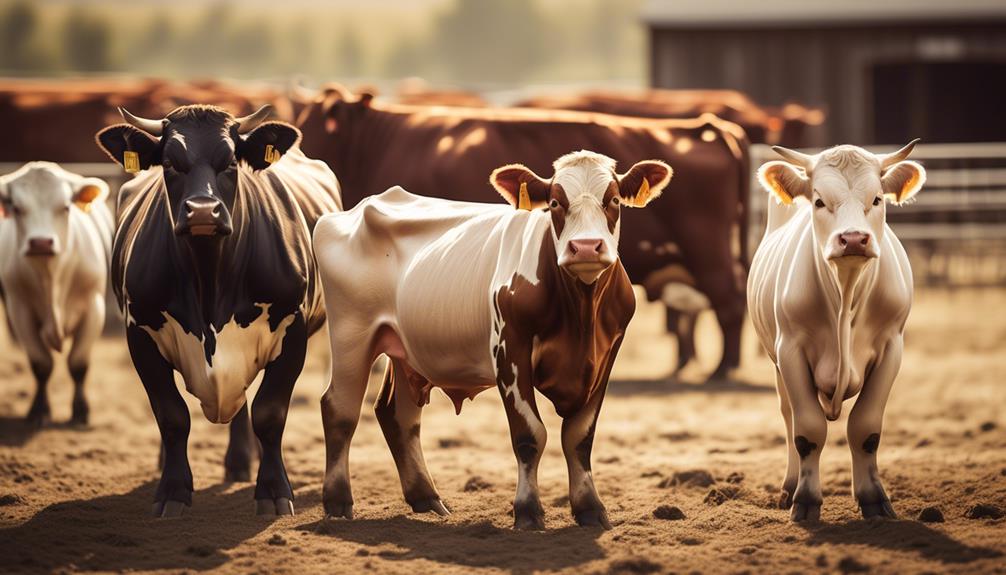
Consider implementing selective breeding strategies to improve the genetic traits related to methane emissions in your cattle herd. Selective breeding allows you to choose specific animals with lower methane emissions and desirable genetic traits to be the parents of the next generation. By doing so, you can gradually reduce methane emissions in your cattle farming operations.
Genetic selection is a key aspect of improving breeding practices to reduce methane emissions. When choosing breeding stock, prioritize animals with a history of lower methane production. Look for cattle that are more efficient in converting their feed into body weight, as this trait is often associated with lower methane emissions. Additionally, consider the animal's lineage and select for traits that are genetically linked to reduced methane production.
It's essential to keep detailed records of each animal's methane emissions and other relevant genetic traits. This data will help you make informed decisions when selecting breeding stock, ultimately leading to a more methane-efficient herd over time. Regular monitoring and assessment of these traits will allow you to track progress and make necessary adjustments to your breeding program.
Enhancing Manure Management
Improving breeding practices to reduce methane emissions in your cattle herd can also lead to enhanced manure management strategies for a more sustainable farming operation. By focusing on enhancing manure management, you can further reduce the environmental impact of your cattle farming activities.
Here are some practical steps you can take to improve manure management on your farm:
- Manure Composting: Implement a composting system to break down manure into nutrient-rich organic matter. This process not only reduces methane emissions but also produces valuable compost that can be used to enhance soil health and fertility on your farm.
- Nutrient Recycling: Explore options for recycling and reusing nutrients from manure. This can involve using manure as a natural fertilizer for crops, reducing the need for synthetic fertilizers. By efficiently recycling nutrients, you can minimize waste and promote a more circular agricultural system.
- Strategic Application: Develop a strategic plan for applying manure to fields. By carefully timing and targeting manure application, you can maximize its benefits for soil health and minimize the potential for nutrient runoff into waterways.
- Investing in Infrastructure: Consider investing in infrastructure for manure storage and application that minimizes methane release. Technologies such as covered lagoons or anaerobic digesters can capture methane for energy production while controlling odors and reducing environmental impact.
Enhancing manure management practices not only contributes to methane reduction but also supports overall sustainability and productivity on your cattle farm.
Utilizing Methane Digesters
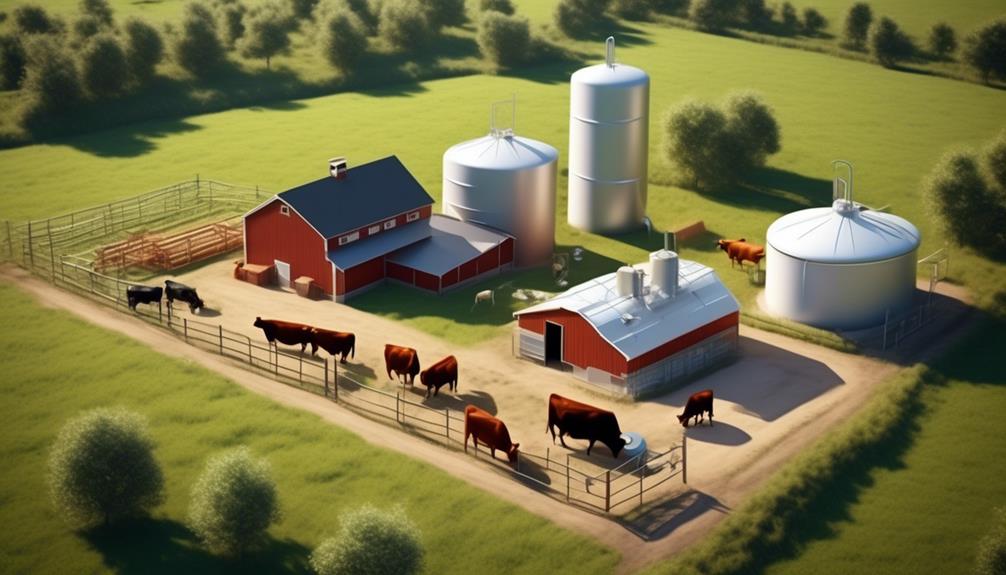
To effectively reduce methane emissions in cattle farming, utilizing methane digesters can play a crucial role in capturing and converting methane into valuable energy resources. Methane digesters are essential for biogas production, providing a renewable energy source while also contributing to methane reduction. These systems operate through anaerobic digestion, a natural process where microorganisms break down organic matter in the absence of oxygen, resulting in the production of biogas.
Methane digesters offer a sustainable solution for managing cattle waste by capturing methane emissions that would otherwise be released into the atmosphere. The captured methane can then be used as a renewable energy source for heating, electricity generation, or even as a vehicle fuel, thereby reducing reliance on non-renewable energy sources and lowering greenhouse gas emissions. By implementing methane digesters, cattle farmers can't only mitigate the environmental impact of methane emissions but also derive economic benefits from the production of biogas.
Furthermore, the use of methane digesters aligns with the circular economy concept, as it allows for the conversion of organic waste into valuable resources. This not only reduces the environmental footprint of cattle farming but also presents opportunities for diversifying income streams through the sale of excess biogas or the use of the digestate, the nutrient-rich byproduct of anaerobic digestion, as a natural fertilizer.
Optimizing Grazing Techniques
Implementing efficient grazing techniques is essential for maximizing cattle productivity while preserving pasture health and quality. Grazing efficiency and rotational grazing techniques play a crucial role in achieving these goals. Here are some practical tips to help you optimize your grazing techniques:
- Implement Rotational Grazing: Divide your pasture into smaller paddocks and rotate cattle through them at regular intervals. This method allows forage plants to recover and regrow, promoting healthier pastures and better grazing opportunities for cattle.
- Monitor Stocking Rates: Avoid overgrazing by carefully monitoring the number of cattle in each paddock. Adjust stocking rates based on forage availability and growth rates to prevent excessive pasture degradation.
- Utilize High-Quality Forage: Introduce a diverse range of high-quality forage species that are well-suited to your specific climate and soil conditions. This approach can improve grazing efficiency by providing a more balanced and nutritious diet for your cattle.
- Invest in Water Systems: Ensure that water sources are easily accessible from all paddocks to encourage even grazing distribution. Adequate water availability throughout the grazing area will support better utilization of the entire pasture.
Investing in Feed Additives
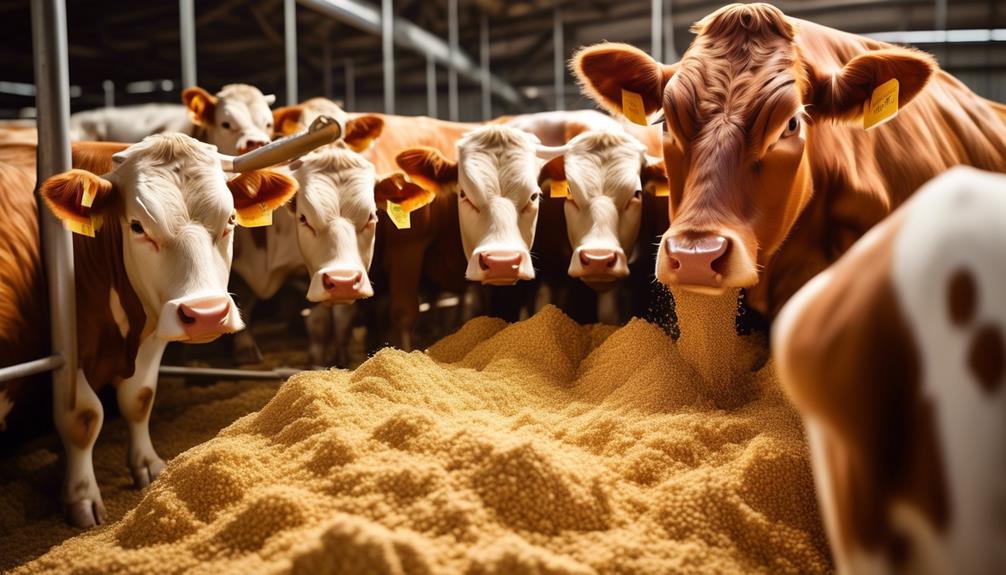
Considering the potential benefits for your cattle's health and productivity, incorporating feed additives into their diet can be a strategic investment for your cattle farming operation.
Feed additives are designed to enhance feed efficiency, ultimately leading to improved cattle performance, while also potentially reducing the environmental impact of your farming activities.
By investing in feed additives, you can optimize your cattle's diet, leading to more efficient digestion and utilization of nutrients, which can positively impact their overall health and productivity.
Feed additives are known to improve feed efficiency by aiding in the digestion process, allowing cattle to extract more nutrients from their feed. This can result in improved weight gain, better utilization of feed resources, and potentially reduced methane emissions per unit of beef produced.
Additionally, certain feed additives can contribute to a more balanced diet for your cattle, promoting healthier digestive systems and overall well-being. As a result, your cattle may require less feed to achieve the same level of productivity, which can lead to cost savings and reduced environmental impact associated with feed production.
Monitoring and Reporting Progress
As you oversee your cattle farming operation, periodically assessing and reporting the progress of methane emission reduction initiatives is critical for ensuring the effectiveness of your sustainability efforts.
Monitoring and reporting progress allows you to make data-driven decisions and showcase your commitment to environmental stewardship. Here's how you can effectively monitor and report your progress:
- Data Analysis: Regularly collect data on methane emissions from your cattle farming activities. Utilize tools such as emissions monitoring equipment and data management software to accurately measure and analyze methane levels. This data will serve as the foundation for assessing the impact of your emission reduction strategies.
- Performance Tracking: Implement a system for tracking the performance of specific initiatives aimed at reducing methane emissions. This could involve keeping records of feed additive usage, dietary changes, or any other interventions. By tracking performance, you can identify which strategies are most effective and make informed adjustments to your practices.
- Periodic Reporting: Develop a reporting schedule to update stakeholders on the progress of your methane emission reduction efforts. Whether it's quarterly, semi-annually, or annually, consistent reporting demonstrates transparency and accountability. Share key metrics, trends, and the impact of emission reduction measures in these reports.
- Feedback Integration: Encourage feedback from employees, stakeholders, and experts involved in your sustainability initiatives. Incorporating diverse perspectives can lead to valuable insights and improvements in your monitoring and reporting processes. Embrace constructive feedback to continuously enhance your methane emission reduction strategies.
Frequently Asked Questions
What Are the Potential Economic Benefits of Reducing Methane Emissions in Cattle Farming?
By reducing methane emissions in cattle farming, you can experience potential economic benefits such as increased efficiency, cost savings, and improved market access. Additionally, health improvements in livestock can lead to reduced veterinary expenses.
Are There Any Potential Health Benefits for the Cattle Associated With Implementing These Changes?
Implementing changes to reduce methane emissions in cattle farming can have potential health benefits for the cattle, such as improved digestion and reduced digestive issues. Additionally, these changes can have a positive environmental impact.
How Do Methane Emissions From Cattle Farming Contribute to Climate Change on a Global Scale?
Methane emissions from cattle farming impact climate change on a global scale. Cattle farming practices, like enteric fermentation and manure management, contribute to methane release. Implementing changes can reduce these emissions and mitigate environmental effects.
Are There Any Government Incentives or Programs Available to Support Farmers in Reducing Methane Emissions?
You can access government incentives and financial support to reduce methane emissions. There are programs in place to help farmers meet regulatory compliance and implement policies for sustainable cattle farming. Take advantage of these resources.
What Are Some Potential Challenges or Barriers That Farmers May Face When Trying to Implement These Changes?
When reducing methane emissions in cattle farming, you may encounter challenges like regulatory compliance and technological limitations. Implementing strategies can help navigate these barriers, such as adopting new feeding techniques and investing in methane-reducing technologies.
Conclusion
You now have the tools to reduce methane emissions in cattle farming.
By implementing dietary changes, improving breeding practices, managing manure, utilizing digesters, optimizing grazing techniques, investing in feed additives, and monitoring progress, you can make a significant impact.
Take action today to create a more sustainable and environmentally-friendly cattle farming operation.
